Copyright 2020 - 2021 irantour.tours all right reserved
Designed by Behsazanhost
Shah Cheragh Mausoleum
Shah Cheragh Mausoleum
Ārāmgāh-e Shāh Cherāgh The Shiite Imam Musa al-Kazem reportedly had forty-one children - eighteen sons and twenty-three daughters. Of these, his son Reza, recognized by the majority of Shiites as their Eighth Imam is the most renowned. Seyed Ahmad ibn Musa entitled Shah Cheragh ('The King of Light), is next to him in fame. During the caliphate of Harun al-Rashid, who is known to most westerners as the character of The Thousand and One Nights, the Khorasan governors of Iran (part of the Abbasid Caliphate at that time) struggled to gain influence as independent rulers. To put down the rebellions, Harun al-Rashid set out for Khorasan and took with him his son Mamun, who for several years was his deputy there.
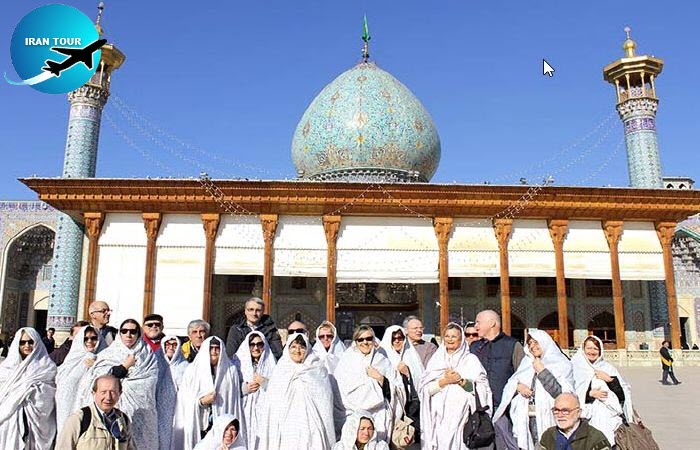 |
Before he died in Tus in Khorasan, Harun al-Rashid willed that his vast realm is divided between two of his sons: Amin, to govern from Baghdad; and Mamun, to rule from Mery in Khorasan. Even so, Harun al-Rashid's death created discord that soon developed into armed conflict between the two brothers. Mamun, in effect stripped by Amin of his rights to the succession, revolted against his brother in one of the most merciless civil wars known to the Islamic East. In order to weaken the orthodox Abbasids, who treated him as a bastard (Mamun was born to an Iranian concubine six months before his half-brother Amin was born to Harun al-Rashid's legitimate wife of Arab blood), Mamun sought to the support of the Iranian Shiites, who were in opposition to the Abbasids. With this in mind, he invited the contemporary Shiite leader, Imam Reza, to join him in Khorasan.
However, Mamun not only failed to achieve his goal, but he found in Imam Reza's supporters another rebelling political force eager to deprive him of power. Having realized this, Mamun reversed his attitude toward Imam Reza. When the news reached the members of
Imam Reza's vast family in Medina hurried to Imam Reza for help. They were on their way to Tus when they were trapped in Shiraz by the enemy. Most of them died in the battle; those who survived and tried to hide in the mountains north of Shiraz were hunted down and killed by Mamun's agents. At roughly the same time, Imam Reza was poisoned.
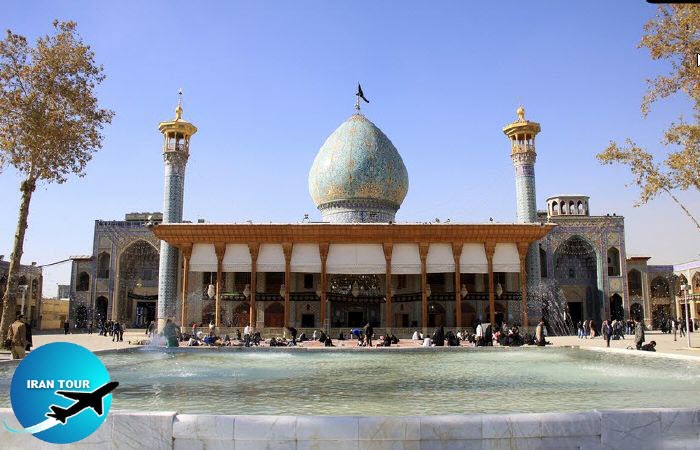 |
The story goes that Ahmad ibn Musa was hiding in the house then occupying the site where his mausoleum was later built and was attacked by Mamun's stooges; he died defending his life. His house was set on fire, and the - body remained under the heap of rubble and ashes. No one was aware that it was there until centuries later during the Atabakan (Salghurid) rule; it was discovered by chance in the course of terracing works. The remains were identified by a seal ring, on which the name of the Imamzadeh was carved.
The first mausoleum, comprising a domed tomb chamber with a colonnaded porch in front of it, was built in the 12th century. The construction was undertaken at the initiative of Moqarab al-Din Masud Badr al-Din, the chief minister of the Salghurid king, and sponsored by Saad ibn Zangi. Various rulers, each in his time, ordered a renovation of the building. During 1344-1349, Shah Sheikh Abu Eshaq Injuid's mother, Queen Tash-Khatun, who was renowned for her piety and charitable activities, built a new dome over the tomb-chamber, annexed to the complex and imposing madrasah and her own crypt, granted thirty volumes of the highly artistic Koran written in golden Tholth in 1345 by Yahya Jamali, and bequeathed to the shrine (to provide its revenue) the village of Meymand, famous for its rose gardens.
Nothing has survived of the Salghurid and Injuid buildings, but the Korans have remained secure and are being preserved in the Shah Cheragh Museum. In 1506, during the reign of Shah Ismail I, the guardian of the mausoleum, Mirza Habibollah Sharifi, initiated important repairs, but in 1588 most of the renovated building collapsed in an earthquake. By the 19th century, the building had been several times damaged and refurbished. In 1824, Hossein Ali Mirza, Governor-general of Fars during the Qajar period, built a dome for the structure, which was repeatedly reinforced in the ensuing years. In 1827, Fathali Shah Qajar presented an ornamental silver casket for the tomb. At the same time, the interior of the shrine was embellished with mirror work and a splendid Tholth inscription, inlaid in the mirror against the background of blue tiles around the drum of the dome.
 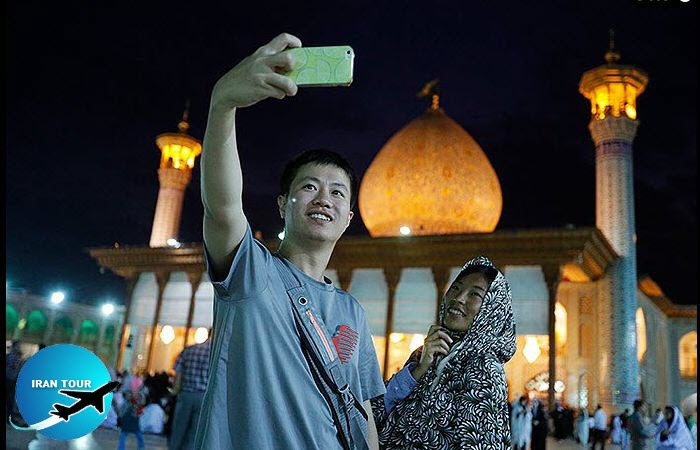 |
During the late 19th century, the building was shaken by a number of severe earthquakes, and further repairs were carried out. In 1958, the dome of the building was replaced by a lighter structure with an iron skeleton, and decorated with glazed tiles as the original cupola had been; the construction was carried out using money raised by the people of Shiraz. In recent years, the complex has been greatly expanded by the addition of administrative buildings, bazaars, arcades, a library, and a museum. The courtyard was paved with stone and provided with a large pool.
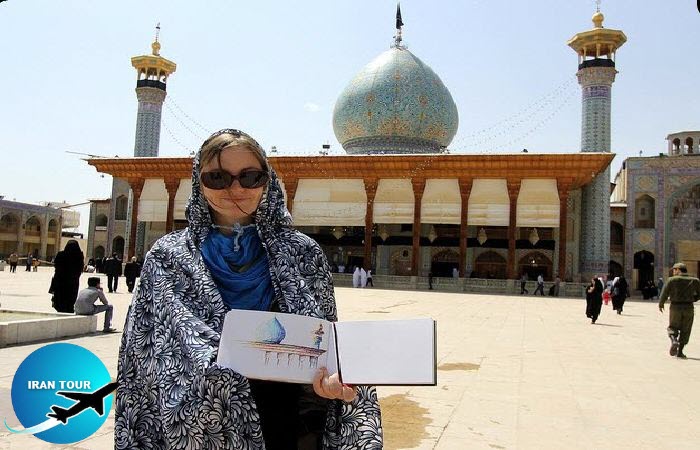 |
The shrine itself consists of a portico on the east, a spacious, domed sanctuary 2 with lofty alcoves on four sides, and a number of minor chambers. With its magnificent carved marble railings, graceful wooden columns, lavish tiles, stucco moldings, and mirror-work, the portico is considered an artistic masterpiece. Two minarets, one situated at each end of the portico, add a note of grandeur to the mausoleum and to the spacious courtyard, which surrounds it on three sides. One of the silver gates linking the portico to the sanctuary, bestowed upon the shrine by Zel al-Sultan, was recently replaced by an inlaid door made by Esfahan's craftsmen; the original gate was removed to the Shah Cheragh Museum. The central square core of the sanctuary is crowned by a dome about 15 m high. Its interior is ornamented with mirrorwork and calligraphy. The tomb, sheltered by a latticed silver casket, is located in a north alcove, rather than directly under the dome; this is a further characteristic of the Shiraz shrines.
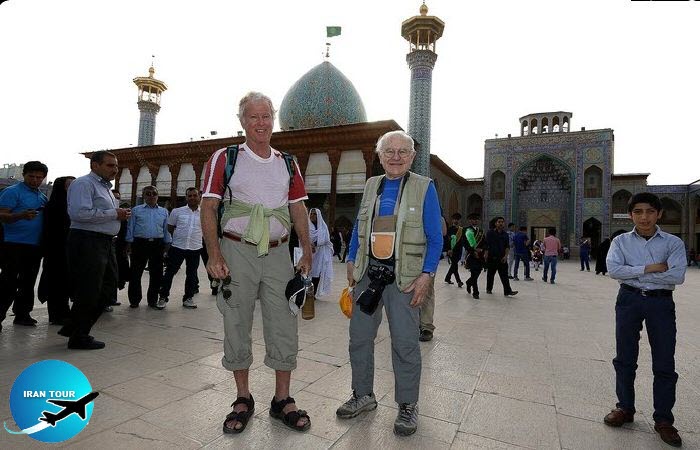 |
Numerous tombs are contiguous to the mausoleum. The most famous of the people buried in the precinct of Shah Cheragh are the mystic Mirza Abulqasem Sokut; the poet Vesal Shirazi; and four of Shirazi's sons, famous artists. Together with the mausoleum of Mir Mohammad, located in the vicinity of Shah Cheragh, the complex occupies 60,000 sq. m, of which 40,000 are under construction. The combined decorative effect of Shah Cheragh's mirror-glass mosaics, inscriptions in stucco, silver-plated doors, inlaid columns, tiled dome, and gilded minaret tops are stunning -All visitors should be dressed very respectfully, and a chador is obligatory for women (it can be borrowed in the bookshop at the entrance). Non-Muslims should ask for permission to be let in - if properly dressed, they are never refused. Cameras are forbidden inside the shrine but permitted in the courtyard.
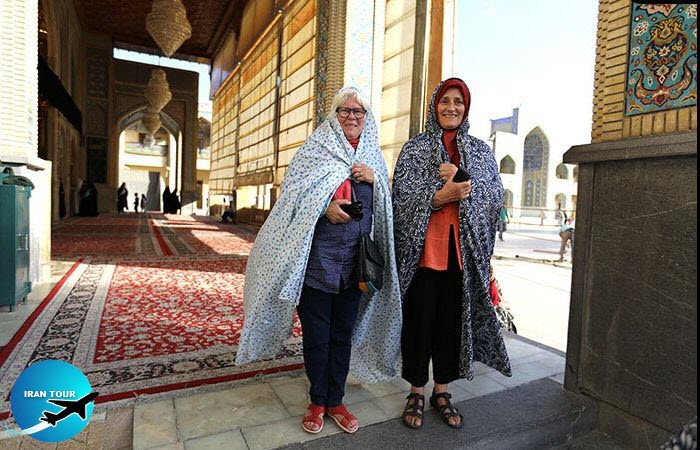 |
Museum
The museum was founded in 1965. In 1997, it moved to a large, new hall. The museum displays donated and bequeathed items, particularly dealing with the Iran-Iraq war and martyrdom. (Among these, the personal belongings of Ayatollah Dastgheib, the preacher of Shiraz, buried in the neighboring Imamzadeh Mir Mohammad, are the most notable). Other objects include ancient coins, weaponry, pottery, glassware, metalware, lamps and candlesticks, paintings, and manuscripts of the Koran.
- Details
- Category: Museums of Shiraz
















